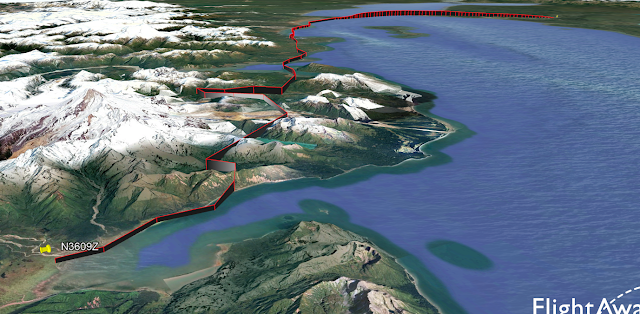This is preliminary information, subject to change, and may contain errors. Any errors in this report will be corrected when the final report has been completed.
https://registry.faa.gov/AircraftInquiry/Search/NNumberResult?nNumberTxt=N716MM
Arne Aviation LLC
- History of Flight:
On July 2, 2025, at about 1723 local time, a Cessna 208B Supervan 900, registered to Arne Aviation LLC out of Suffolk, Virginia, N716MM, sustained substantial damage when it impacted trees following a runway overrun at Cross Keys Airport (17N), Cross Keys, New Jersey. There was one pilot and thirteen passengers onboard. Five occupants received unspecified injuries. The flight was being conducted as a 14 Code of Federal Regulations Part 91 skydiving flight.
According to preliminary flight-track history, earlier in the day, at about 1629 LT, the airplane departed 17N on an 18-minute flight. It departed runway 27 and conducted a climbing right turn to an altitude of 3,000 ft before it preceded to the east and continued flying until it reached 8,000 ft. At this point, it turned around, while still climbing, and overflew the airport at an altitude of 13500 ft, where it presumably dropped the skydivers. The airplane then flew south of the airport, conducted two orbits, then proceeded to land on runway 27.
Later in the day, at about 1519 LT, the airplane departed runway 27 on the accident flight. It conducted a climbing right turn to an altitude of 3,000 ft, before it stopped the climb and started flying northwest (back to the airport). At 1523:07, the airplane was at 1675 ft, 112 knots, and descending towards the runway when it entered a orbit. The airplane briefly climbed to 1750 ft before it started to descent. At the conclusion of the orbit, at 1723:41, the airplane was at 1025 ft, 96 knots, and descending -2600 fpm. The last ADS-B return was recorded 7 seconds later at 1723:48. The airplane was at 525 ft, 111 knots groundspeed, and descending 3100 fpm. It was recorded less than 0.20 mile from the runway 27 threshold. (figure 1)
The airplane impacted trees off the departure end of runway 27. There was no post crash fire.
Figure 1: ADS-B data
- Pilot Info:
UNKNOWN AT THIS TIME
- Wreckage and Impact Information:
UNKNOWN AT THIS TIME
- Aircraft Info:
The accident aircraft, MSN 208B0746, was powered by a Honeywell TPE331-12JR engine, rated at 900 Horsepower.
According to NTSB records, the airplane was involved in an accident on 3 July 2023 at Suffolk Executive Airport (KSFQ), Virginia, when it suffered a nose gear collapse. (look in "additional information" for the accident narrative). At the time, the airplane was equipped with 12 seats, and the certified Max Gross Weight was 9062 lbs. The total airframe hours were 9519.
- Airport Info:
Cross Keys Airport (17N) is a privately-owned, public use airport located one nautical mile south of the Cross Keys, New Jersey. The airport is commonly used for skydiving operation. It features one runway designated 9/27 with an asphalt surface measuring 3,500 by 50 feet. The airport elevation was 162 ft.
One airport remark states; "Due to parachute drop zone on north side of airport, all traffic to remain south of runway 09/27."
- Weather:
Weather conditions at KPHL, located 14 nautical miles away from 17N, at 1656 local time, were reported to be, in part: wind 210° at 8 knots; visibility 10 statute miles; few clouds at 3,500 feet. A scattered ceiling at 7,000 ft. Two broken layers at 23,000 ft, and 35,000 ft, temperature: 30°C, dewpoint: 21°C, and an altimeter setting of 29.85 inches of mercury.
METAR KPHL 022054Z 21008KT 10SM FEW035 SCT070 BKN230 BKN350 30/21 A2985 RMK AO2 SLP107 T03000206 56012 $
METAR KPHL 022154Z 21007KT 10SM FEW040 SCT075 SCT230 BKN350 31/21 A2985 RMK AO2 SLP107 T03060206 $
- Additional Information:
2010 Accident:
On 10 October 2010, the airplane was being operated by Makalu Air in Nepal when it was involved in a runway excursion at Simikot Airport (IMK/VNST). The nose and right main gear collapsed.
2023 Accident:
The pilot was returning from her fifth skydive run of the day. During the landing, 'the flare seemed insufficient' and the nose landing gear collapsed during touchdown. The airplane continued off the side of the runway and came to rest in the grass. During the accident sequence, the airplane sustained substantial damage to the engine mounts.
The NTSB determined the probable cause to be; "The pilot's inadequate landing flare, which resulted in a nose landing gear collapse."












